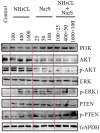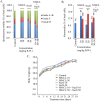Hydrogen Sulfide and/or Ammonia Reduces Spermatozoa Motility through AMPK/AKT Related Pathways
- PMID: 27883089
- PMCID: PMC5121643
- DOI: 10.1038/srep37884
Hydrogen Sulfide and/or Ammonia Reduces Spermatozoa Motility through AMPK/AKT Related Pathways
Abstract
A number of emerging studies suggest that air pollutants such as hydrogen sulfide (H2S) and ammonia (NH3) may cause a decline in spermatozoa motility. The impact and underlying mechanisms are currently unknown. Boar spermatozoa (in vitro) and peripubertal male mice (in vivo) were exposed to H2S and/or NH3 to evaluate the impact on spermatozoa motility. Na2S and/or NH4Cl reduced the motility of boar spermatozoa in vitro. Na2S and/or NH4Cl disrupted multiple signaling pathways including decreasing Na+/K+ ATPase activity and protein kinase B (AKT) levels, activating Adenosine 5'-monophosphate (AMP)-activated protein kinase (AMPK) and phosphatase and tensin homolog deleted on chromosome ten (PTEN), and increasing reactive oxygen species (ROS) to diminish boar spermatozoa motility. The increase in ROS might have activated PTEN, which in turn diminished AKT activation. The ATP deficiency (indicated by reduction in Na+/K+ ATPase activity), transforming growth factor (TGFβ) activated kinase-1 (TAK1) activation, and AKT deactivation stimulated AMPK, which caused a decline in boar spermatozoa motility. Simultaneously, the deactivation of AKT might play some role in the reduction of boar spermatozoa motility. Furthermore, Na2S and/or NH4Cl declined the motility of mouse spermatozoa without affecting mouse body weight gain in vivo. Findings of the present study suggest that H2S and/or NH3 are adversely associated with spermatozoa motility.
Figures







Similar articles
-
Ochratoxin A exposure decreased sperm motility via the AMPK and PTEN signaling pathways.Toxicol Appl Pharmacol. 2018 Feb 1;340:49-57. doi: 10.1016/j.taap.2017.12.011. Epub 2017 Dec 21. Toxicol Appl Pharmacol. 2018. PMID: 29274354
-
Decrease in male mouse fertility by hydrogen sulfide and/or ammonia can Be inheritable.Chemosphere. 2018 Mar;194:147-157. doi: 10.1016/j.chemosphere.2017.11.164. Epub 2017 Nov 30. Chemosphere. 2018. PMID: 29202267
-
Toxic effects and possible mechanisms of hydrogen sulfide and/or ammonia on porcine oocyte maturation in vitro.Toxicol Lett. 2018 Mar 15;285:20-26. doi: 10.1016/j.toxlet.2017.12.019. Epub 2017 Dec 29. Toxicol Lett. 2018. PMID: 29292088
-
New insights into Notch1 regulation of the PI3K-AKT-mTOR1 signaling axis: targeted therapy of γ-secretase inhibitor resistant T-cell acute lymphoblastic leukemia.Cell Signal. 2014 Jan;26(1):149-61. doi: 10.1016/j.cellsig.2013.09.021. Epub 2013 Oct 16. Cell Signal. 2014. PMID: 24140475 Review.
-
New insights into transduction pathways that regulate boar sperm function.Theriogenology. 2016 Jan 1;85(1):12-20. doi: 10.1016/j.theriogenology.2015.05.008. Epub 2015 May 14. Theriogenology. 2016. PMID: 26074068 Review.
Cited by
-
The in vitro effects of gibberellin on human sperm motility.Aging (Albany NY). 2019 May 22;11(10):3080-3093. doi: 10.18632/aging.101963. Aging (Albany NY). 2019. PMID: 31118311 Free PMC article.
-
Hydrogen sulfide repairs testicular damage induced by heat stress in rats.FEBS Open Bio. 2025 Jun;15(6):963-971. doi: 10.1002/2211-5463.70010. Epub 2025 Mar 5. FEBS Open Bio. 2025. PMID: 40040558 Free PMC article.
-
Ritonavir Has Reproductive Toxicity Depending on Disrupting PI3K/PDK1/AKT Signaling Pathway.Toxics. 2024 Jan 15;12(1):73. doi: 10.3390/toxics12010073. Toxics. 2024. PMID: 38251029 Free PMC article.
-
Effect of Zearalenone-Induced Ferroptosis on Mice Spermatogenesis.Animals (Basel). 2022 Nov 3;12(21):3026. doi: 10.3390/ani12213026. Animals (Basel). 2022. PMID: 36359150 Free PMC article.
-
A Study of the Regulatory Mechanism of the CB1/PPARγ2/PLIN1/HSL Pathway for Fat Metabolism in Cattle.Front Genet. 2021 May 4;12:631187. doi: 10.3389/fgene.2021.631187. eCollection 2021. Front Genet. 2021. PMID: 34017353 Free PMC article.
References
-
- Birdsall M. A. Sperm quality in New Zealand: Is the downward trend continuing. N. Z. Med. J. 128(1423), 50–56 (2015). - PubMed
-
- Centola G. M., Blanchard A., Demick J., Li S. & Eisenberg M. L. Decline in sperm count and motility in young adult men from 2003 to 2013: observations from a U.S. Sperm Bank. Andrology 4(2), 270–276 (2016). - PubMed
-
- Hammoud A. et al.. Decreased sperm motility is associated with air pollution in Salt Lake City. Fertil. Steril. 93(6), 1875–1879 (2010). - PubMed
-
- Wijesekara G. U., Fernando D. M., Wijerathna S. & Bandara N. Environmental and occupational exposures as a cause of male infertility. Ceylon Med. J. 60(2), 52–56 (2015). - PubMed
Publication types
LinkOut - more resources
Full Text Sources
Other Literature Sources
Research Materials
Miscellaneous

